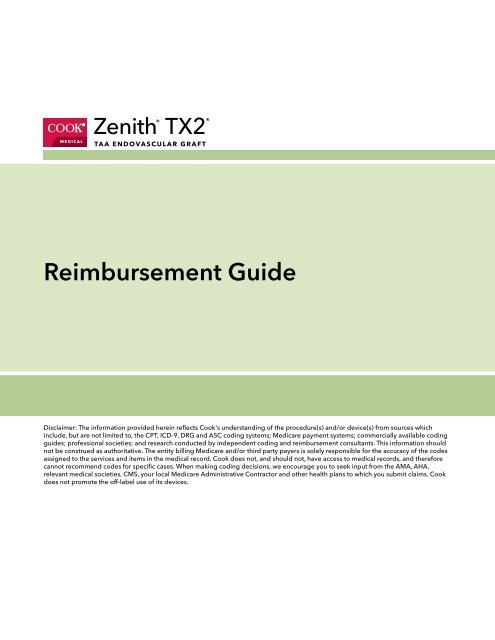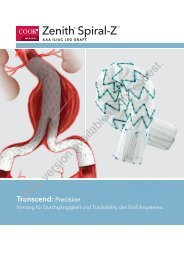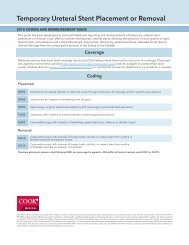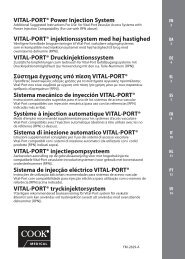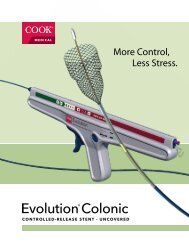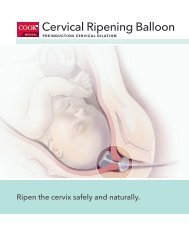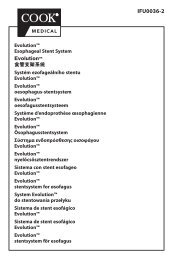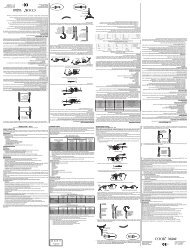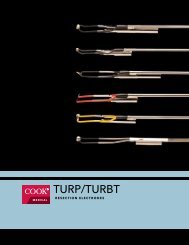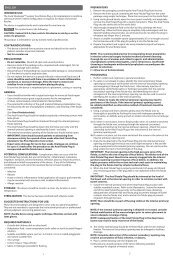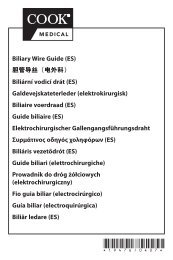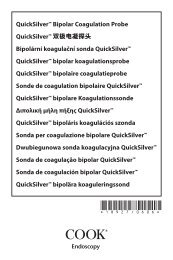Zenith TX2 with Pro-Form TAA Endovascular Graft - Cook Medical
Zenith TX2 with Pro-Form TAA Endovascular Graft - Cook Medical
Zenith TX2 with Pro-Form TAA Endovascular Graft - Cook Medical
You also want an ePaper? Increase the reach of your titles
YUMPU automatically turns print PDFs into web optimized ePapers that Google loves.
<strong>Zenith</strong> ®<br />
<strong>TX2</strong> ®<br />
TA A E N D O VA S C U L A R G R A F T<br />
Reimbursement Guide<br />
Disclaimer: The information provided herein reflects <strong>Cook</strong>'s understanding of the procedure(s) and/or device(s) from sources which<br />
include, but are not limited to, the CPT, ICD-9, DRG and ASC coding systems; Medicare payment systems; commercially available coding<br />
guides; professional societies; and research conducted by independent coding and reimbursement consultants. This information should<br />
not be construed as authoritative. The entity billing Medicare and/or third party payers is solely responsible for the accuracy of the codes<br />
assigned to the services and items in the medical record. <strong>Cook</strong> does not, and should not, have access to medical records, and therefore<br />
cannot recommend codes for specific cases. When making coding decisions, we encourage you to seek input from the AMA, AHA,<br />
relevant medical societies, CMS, your local Medicare Administrative Contractor and other health plans to which you submit claims. <strong>Cook</strong><br />
does not promote the off-label use of its devices.
2 IntroductIon<br />
4 coverage<br />
4 codIng<br />
a. What Is a Thoracic Aortic Aneurysm (<strong>TAA</strong>)?<br />
b. How Is a Typical <strong>TAA</strong> Endograft <strong>Pro</strong>cedure Performed?<br />
a. Facility<br />
b. Physician<br />
i. CPT® Coding Conventions for <strong>Endovascular</strong> Repairs<br />
ii. Steps of an <strong>Endovascular</strong> Repair—Thoracic Aortic Aneurysm<br />
iii. Ancillary <strong>Pro</strong>cedures<br />
iv. Embolization<br />
v. Modifiers<br />
8 payment<br />
Physician Reimbursement for <strong>TX2</strong> Placement<br />
10 physIcIan codIng scenarIos<br />
12 frequently asked questIons<br />
12 reImbursement contact InformatIon<br />
CPT © 2011 American <strong>Medical</strong> Association. All rights reserved. CPT is a registered trademark of the American <strong>Medical</strong> Association.<br />
Disclaimer: The information provided herein reflects <strong>Cook</strong>'s understanding of the procedure(s) and/or device(s) from sources which include,<br />
but are not limited to, the CPT, ICD-9, DRG and ASC coding systems; Medicare payment systems; commercially available coding guides;<br />
professional societies; and research conducted by independent coding and reimbursement consultants. This information should not be<br />
construed as authoritative. The entity billing Medicare and/or third party payers is solely responsible for the accuracy of the codes assigned<br />
to the services and items in the medical record. <strong>Cook</strong> does not, and should not, have access to medical records, and therefore cannot recommend<br />
codes for specific cases. When making coding decisions, we encourage you to seek input from the AMA, AHA, relevant medical<br />
societies, CMS, your local Medicare Administrative Contractor and other health plans to which you submit claims. <strong>Cook</strong> does not promote<br />
the off-label use of its devices.
IntRoductIon<br />
This guide was developed to assist physicians and hospital<br />
coding and reimbursement staff <strong>with</strong> Medicare coding<br />
and reimbursement when placing the <strong>Zenith</strong> <strong>TX2</strong> <strong>TAA</strong><br />
<strong>Endovascular</strong> <strong>Graft</strong>.<br />
What Is a thoracic Aortic Aneurysm?<br />
The aorta is the largest artery in the body and is responsible for<br />
carrying blood from the heart to the rest of the body. It extends<br />
upward from the heart through the chest and then arches and<br />
descends into the abdomen. Sometimes, <strong>with</strong> aging or other<br />
changes, a section of the aorta weakens and begins to bulge.<br />
This bulge can enlarge over time as the walls of the aorta<br />
become thinner and stretch. This bulge in the aorta is called<br />
an aneurysm.<br />
When an aneurysm occurs in the part of the aorta that runs<br />
through the chest, it is called a thoracic aortic aneurysm, or <strong>TAA</strong>.<br />
Thoracic aortic aneurysms occur most often in the descending<br />
thoracic aorta (50 percent of the time) followed by the ascending<br />
aorta (25 percent of the time) and the aortic arch (25 percent of<br />
the time).<br />
In the early stages, when a <strong>TAA</strong> is small, it may not pose an<br />
immediate health risk. If the <strong>TAA</strong> continues to grow, the aorta’s<br />
walls become thin and lose their ability to stretch. The weakened<br />
sections of the aortic wall may become unable to support the<br />
force of blood flow. The aneurysm could rupture, causing serious<br />
internal bleeding.<br />
How Is a typical tAA Endograft<br />
<strong>Pro</strong>cedure Performed?<br />
The patient is typically placed under general anesthesia and<br />
prepped for the procedure. The physician performs a cutdown<br />
of a femoral or iliac artery to expose the blood vessel. Wires,<br />
introducer sheaths, catheters and the <strong>TX2</strong> device are introduced<br />
and placed under fluoroscopy into the thoracic aorta where<br />
the <strong>TX2</strong> endograft is deployed. The <strong>TX2</strong> main body has both<br />
proximal and distal components. These are two separate<br />
device components <strong>with</strong> two separate delivery systems; they<br />
are designed to overlap each other for part of their length.<br />
Together they make up the “main body” of the <strong>TX2</strong> device. In<br />
some procedures both proximal and distal components will be<br />
used; in other procedures, particularly for short aneurysms, only<br />
the proximal component will be required. Distal and proximal<br />
extensions may be added to the main body component(s) to<br />
accommodate the patient’s anatomy. Additional steps may be<br />
required and could include use of balloons, stents or other<br />
devices. Embolization may also be needed prior to graft<br />
placement if the subclavian is covered by the endograft and a<br />
carotid-subclavian bypass is needed for adequate circulation.<br />
Once the procedure is complete, the physician repairs all<br />
cutdowns and closes.<br />
2<br />
CPT<br />
KIDNEY<br />
© 2011 American <strong>Medical</strong> Association. All rights reserved. CPT is a registered trademark of the American <strong>Medical</strong> Association.<br />
Disclaimer: The information provided herein reflects <strong>Cook</strong>'s understanding of the procedure(s) and/or device(s) from sources which include,<br />
but are not limited to, the CPT, ICD-9, DRG and ASC coding systems; Medicare payment systems; commercially available coding guides;<br />
professional societies; and research conducted by independent coding and reimbursement consultants. This information should not be<br />
construed as authoritative. The entity billing Medicare and/or third party payers is solely responsible for the accuracy of the codes assigned<br />
to the services and items in the medical record. <strong>Cook</strong> does not, and should not, have access to medical records, and therefore cannot recommend<br />
codes for specific cases. When making coding decisions, we encourage you to seek input from the AMA, AHA, relevant medical<br />
societies, CMS, your local Medicare Administrative Contractor and other health plans to which you submit claims. <strong>Cook</strong> does not promote<br />
the off-label use of its devices.<br />
HEART<br />
AORTA<br />
RIGHT<br />
COMMON<br />
ILIAC ARTERY<br />
KIDNEY<br />
NORMAl AORTA<br />
HEART<br />
AORTA<br />
RIGHT<br />
COMMON<br />
ILIAC ARTERY<br />
LEFT<br />
COMMON<br />
ILIAC ARTERY<br />
ANEURYSM<br />
LEFT<br />
COMMON<br />
ILIAC ARTERY<br />
THORACIC AORTIC ANEuRySM
Diameter<br />
Diameter<br />
Distal<br />
Component<br />
Length<br />
<strong>Pro</strong>ximal<br />
Extension<br />
Length<br />
<strong>Pro</strong>ximal<br />
Diameter<br />
Distal<br />
Diameter<br />
(4 mm less than proximal diameter)<br />
Diameter<br />
<strong>Pro</strong>ximal<br />
Tapered<br />
Component<br />
Length<br />
Distal<br />
Extension<br />
Length<br />
CPT © 2011 American <strong>Medical</strong> Association. All rights reserved. CPT is a registered trademark of the American <strong>Medical</strong> Association.<br />
Disclaimer: The information provided herein reflects <strong>Cook</strong>'s understanding of the procedure(s) and/or device(s) from sources which<br />
include, but are not limited to, the CPT, ICD-9, DRG and ASC coding systems; Medicare payment systems; commercially available<br />
coding guides; professional societies; and research conducted by independent coding and reimbursement consultants. This information<br />
should not be construed as authoritative. The entity billing Medicare and/or third party payers is solely responsible for the<br />
accuracy of the codes assigned to the services and items in the medical record. <strong>Cook</strong> does not, and should not, have access to medical<br />
records, and therefore cannot recommend codes for specific cases. When making coding decisions, we encourage you to seek<br />
input from the AMA, AHA, relevant medical societies, CMS, your local Medicare Administrative Contractor and other health plans to<br />
which you submit claims. <strong>Cook</strong> does not promote the off-label use of its devices.<br />
Diameter<br />
<strong>Pro</strong>ximal<br />
Component<br />
Length<br />
3
covERAGE<br />
Medicare sometimes issues coverage policies indicating<br />
under what circumstances they will/will not cover a particular<br />
medical service or procedure. On occasion, these policies are<br />
issued as national coverage policies affecting all Medicare<br />
patients. Other times they are issued by local Medicare<br />
contractors as local coverage decisions (lCDs) affecting<br />
only those Medicare beneficiaries in a given contractor’s<br />
jurisdiction. At this point in time, Medicare has not issued a<br />
national coverage decision about endovascular treatment of<br />
thoracic aortic aneurysms. However, we encourage physicians<br />
to periodically check <strong>with</strong> their local Medicare carrier(s) for<br />
coverage policies on this topic to see if they have issued an<br />
lCD. lCDs can be searched at the CMS coverage database:<br />
http://www.cms.hhs.gov/mcd/search.asp?, and if you need to<br />
contact your local contractors’ <strong>Medical</strong> Directors, their contact<br />
information is accessible at www.cms.hhs.gov/apps/contacts/.<br />
codInG<br />
Facility coding<br />
Facilities should report the following ICD-9 procedure code for<br />
deployment of the <strong>Zenith</strong> <strong>TX2</strong> endograft to treat <strong>TAA</strong>:<br />
39.73 <strong>Endovascular</strong> implantation of graft in thoracic aorta<br />
In their final rule for the fiscal year 2012 (effective October<br />
1, 2011) Hospital Inpatient <strong>Pro</strong>spective Payment System,<br />
Medicare determined that all patients admitted to hospitals<br />
for endovascular repair of <strong>TAA</strong> will be assigned to one of the<br />
following DRGs:<br />
DRG 216<br />
DRG 217<br />
DRG 218<br />
4 CPT<br />
Cardiac Valve and Other Major<br />
Cardiothoracic <strong>Pro</strong>cedures<br />
<strong>with</strong> Cardiac Catheterization<br />
<strong>with</strong> Major Complications and<br />
Comorbidities<br />
Cardiac Valve and Other Major<br />
Cardiothoracic <strong>Pro</strong>cedures<br />
<strong>with</strong> Cardiac Catheterization<br />
<strong>with</strong> Complications and<br />
Comorbidities<br />
Cardiac Valve and Other Major<br />
Cardiothoracic <strong>Pro</strong>cedures<br />
<strong>with</strong> Cardiac Catheterization<br />
<strong>with</strong>out Complications<br />
or Comorbidities or<br />
Major Complications and<br />
Comorbidities<br />
Relative Weight 1,2<br />
9.6922<br />
6.4987<br />
5.1734<br />
DRG 219<br />
DRG 220<br />
DRG 221<br />
Cardiac Valve and Other<br />
Major Cardiothoracic<br />
<strong>Pro</strong>cedures <strong>with</strong>out Cardiac<br />
Catheterization <strong>with</strong><br />
Major Complications and<br />
Comorbidities<br />
Cardiac Valve and Other<br />
Major Cardiothoracic<br />
<strong>Pro</strong>cedures <strong>with</strong>out<br />
Cardiac Catheterization<br />
<strong>with</strong> Complications and<br />
Comorbidities<br />
Cardiac Valve and Other<br />
Major Cardiothoracic<br />
<strong>Pro</strong>cedures <strong>with</strong>out<br />
Cardiac Catheterization<br />
<strong>with</strong>out Complications<br />
or Comorbidities or<br />
Major Complications and<br />
Comorbidities<br />
8.0815<br />
5.2602<br />
4.3663<br />
1. Hart A, ed. Appendix D. In: DRG Expert: A Comprehensive Guidebook<br />
to the DRG Classification System. 28th ed. Eden Prairie, MN:<br />
OptumInsight; 2011<br />
2. Individual hospital payment levels differ based on geographic location,<br />
bed size, teaching status and the percentage of low income patients.<br />
Physician coding<br />
cPt coding conventions for <strong>Endovascular</strong> Repairs<br />
The work described by the <strong>TAA</strong> repair code(s) includes the<br />
pre-, intra- and postoperative care involved in placement of<br />
the endograft.<br />
preoperative work includes:<br />
- measurement of preoperative imaging studies<br />
- redetermination of candidacy for endovascular<br />
<strong>TAA</strong> repair<br />
- selection of type and size of graft<br />
- final discussions <strong>with</strong> patient and family regarding risks and<br />
benefits of the procedure<br />
- preoperative supervision of OR setup<br />
- selection of appropriate equipment such as catheters, wire<br />
guides, etc.<br />
- direction of the OR and x-ray personnel<br />
Intraoperative work includes:<br />
- introduction of the device into the vessel(s), positioning the<br />
device, and ballooning of the anastomotic hooks and graft<br />
- all angioplasty, stenting and ballooning performed <strong>with</strong>in the<br />
© 2011 American <strong>Medical</strong> Association. All rights reserved. CPT is a registered trademark of the American <strong>Medical</strong> Association.<br />
Disclaimer: The information provided herein reflects <strong>Cook</strong>'s understanding of the procedure(s) and/or device(s) from sources which include,<br />
but are not limited to, the CPT, ICD-9, DRG and ASC coding systems; Medicare payment systems; commercially available coding guides;<br />
professional societies; and research conducted by independent coding and reimbursement consultants. This information should not be<br />
construed as authoritative. The entity billing Medicare and/or third party payers is solely responsible for the accuracy of the codes assigned<br />
to the services and items in the medical record. <strong>Cook</strong> does not, and should not, have access to medical records, and therefore cannot recommend<br />
codes for specific cases. When making coding decisions, we encourage you to seek input from the AMA, AHA, relevant medical<br />
societies, CMS, your local Medicare Administrative Contractor and other health plans to which you submit claims. <strong>Cook</strong> does not promote<br />
the off-label use of its devices.
target treatment zone of the graft before, during and after<br />
endograft placement<br />
- placement of distal extensions (during initial procedure)<br />
- any additional ballooning, stents, or components used <strong>with</strong>in<br />
the graft to seat and open the endograft<br />
postoperative care includes:<br />
- routine care and outpatient or inpatient visits related to <strong>TAA</strong><br />
repair for a period of 90 days<br />
Steps of an <strong>Endovascular</strong> Repair—thoracic<br />
Aortic Aneurysm<br />
Step 1:<br />
Surgical Exposure of Artery for Endograft Delivery<br />
The codes used to describe open exposure of access vessels,<br />
i.e., femoral or iliac artery(s), include both the work of exposing<br />
the vessel and closing of the exposure site(s). The code(s) used<br />
to report access are:<br />
34812<br />
34820<br />
34833<br />
34834<br />
Open femoral artery exposure for delivery of endovascular<br />
prosthesis, by groin incision, unilateral<br />
(For bilateral procedure, use modifier ‘-50’)<br />
Open iliac artery exposure for delivery of endovascular<br />
prosthesis or iliac occlusion during endovascular therapy,<br />
by abdominal or retroperitoneal incision, unilateral<br />
(For bilateral procedure, use modifier ‘-50’)<br />
Open iliac artery exposure <strong>with</strong> creation of conduit for<br />
delivery of aortic or iliac endovascular prosthesis, by<br />
abdominal or retroperitoneal incision, unilateral<br />
(do not report 34833 in addition to 34820)<br />
(For bilateral procedure, use modifier ‘-50’)<br />
Open brachial artery exposure to assist in the deployment<br />
of aortic or iliac endovascular prosthesis by arm incision,<br />
unilateral (For bilateral procedure, use modifier ‘-50’)<br />
In some cases, the iliac arteries are too small to allow<br />
introduction of the endograft device, and a conduit (34833)<br />
is required to permit delivery of the endograft into the aorta.<br />
The conduit may be permanently attached to the iliac or<br />
femoral artery or it may be removed. Once 34833 is reported,<br />
correct coding convention dictates procedure code 34820<br />
should not be reported, because 34833 includes the work of<br />
iliac artery exposure.<br />
Step 2:<br />
Placement of Wires/Catheters/Sheaths<br />
Once access has been established, wire guides, catheters, and/or<br />
sheaths are introduced either percutaneously or through arterial<br />
CPT © 2011 American <strong>Medical</strong> Association. All rights reserved. CPT is a registered trademark of the American <strong>Medical</strong> Association.<br />
Disclaimer: The information provided herein reflects <strong>Cook</strong>'s understanding of the procedure(s) and/or device(s) from sources which<br />
include, but are not limited to, the CPT, ICD-9, DRG and ASC coding systems; Medicare payment systems; commercially available<br />
coding guides; professional societies; and research conducted by independent coding and reimbursement consultants. This information<br />
should not be construed as authoritative. The entity billing Medicare and/or third party payers is solely responsible for the<br />
accuracy of the codes assigned to the services and items in the medical record. <strong>Cook</strong> does not, and should not, have access to medical<br />
records, and therefore cannot recommend codes for specific cases. When making coding decisions, we encourage you to seek<br />
input from the AMA, AHA, relevant medical societies, CMS, your local Medicare Administrative Contractor and other health plans to<br />
which you submit claims. <strong>Cook</strong> does not promote the off-label use of its devices.<br />
exposure(s) to deliver and correctly place the endograft. At least<br />
one catheterization code is reported for each vessel accessed,<br />
and quite often bilateral catheters are introduced into the aorta<br />
and reported <strong>with</strong> the -50 modifier. The code(s) to report are:<br />
36200<br />
36200-50<br />
Introduction of catheter, aorta<br />
Introduction of catheter, aorta - bilaterally<br />
Physicians should code selective catheter placement according<br />
to established guidelines.<br />
Step 3:<br />
Placement and Deployment of Thoracic Endograft<br />
The endograft is introduced into the abdominal aorta and<br />
advanced to the target treatment area in the descending thoracic<br />
aorta (33880-33881). Once the endograft is deployed, the work<br />
associated <strong>with</strong> “seating” by fully opening the endograft using<br />
balloon dilatations, stents or endograft module(s) is included<br />
in the CPT procedure description and should not be separately<br />
reported. Physicians should report one of the following<br />
procedure codes when a <strong>Cook</strong> <strong>Zenith</strong> <strong>TX2</strong> device is placed<br />
(Note: These codes apply whether just the proximal component<br />
or both the proximal and distal components of a <strong>Zenith</strong> <strong>TX2</strong><br />
device are used in the procedure):<br />
33880<br />
33881<br />
<strong>Endovascular</strong> repair of descending thoracic aorta (e.g.,<br />
aneurysm, pseudoaneurysm, dissection, penetrating<br />
ulcer, intramural hematoma, or traumatic disruption);<br />
involving coverage of left subclavian artery origin,<br />
initial endoprosthesis plus descending thoracic aortic<br />
extension(s), if required, to level of celiac artery origin<br />
(For radiological supervision and interpretation, use<br />
75956 in conjunction <strong>with</strong> 33880)<br />
<strong>Endovascular</strong> repair of descending thoracic aorta (e.g.,<br />
aneurysm, pseudoaneurysm, dissection, penetrating<br />
ulcer, intramural hematoma, or traumatic disruption);<br />
not involving coverage of left subclavian artery origin,<br />
initial endoprosthesis plus descending thoracic aortic<br />
extension(s), if required, to level of celiac artery origin (For<br />
radiological supervision and interpretation, use 75957 in<br />
conjunction <strong>with</strong> 33881)<br />
Physicians should also report the appropriate radiological<br />
supervision and interpretation code along <strong>with</strong> the professional<br />
component modifier -26.<br />
5
75956-26<br />
75957-26<br />
6 CPT<br />
<strong>Endovascular</strong> repair of descending thoracic aorta (e.g.,<br />
aneurysm, pseudoaneurysm, dissection, penetrating<br />
ulcer, intramural hematoma, or traumatic disruption);<br />
involving coverage of left subclavian artery origin,<br />
initial endoprosthesis plus descending thoracic aortic<br />
extension(s), if required, to level of celiac artery origin,<br />
radiological supervision and interpretation<br />
<strong>Endovascular</strong> repair of descending thoracic aorta (e.g.,<br />
aneurysm, pseudoaneurysm, dissection, penetrating<br />
ulcer, intramural hematoma, or traumatic disruption);<br />
not involving coverage of left subclavian artery origin,<br />
initial endoprosthesis plus descending thoracic aortic<br />
extension(s), if required, to level of celiac artery origin,<br />
radiological supervision and interpretation<br />
CPT codes 75956 and 75957 include all work associated<br />
<strong>with</strong> imaging during endograft placement, the aortogram<br />
performed at the beginning of the procedure, fluoroscopic<br />
guidance, road-mapping and completion angiography. All<br />
supervision and interpretation services involving angioplasty,<br />
balloon expansion of the endograft or “seating,” and stenting<br />
performed <strong>with</strong>in the endograft zone during the procedure<br />
are included in these codes.<br />
Step 4:<br />
Placement of Extensions<br />
Extensions are devices used to elongate the target treatment<br />
area and help custom fit the device to each patient’s anatomy.<br />
<strong>Pro</strong>ximal extensions deployed during initial thoracic endograft<br />
placement are separately reported, and coding choice will vary<br />
depending on whether there is coverage of the subclavian artery<br />
origin. <strong>Pro</strong>ximal extension(s) resulting in noncoverage of the left<br />
subclavian origin are reported <strong>with</strong> the following code(s):<br />
33883<br />
+33884<br />
Placement of proximal extension prosthesis for<br />
endovascular repair of descending thoracic aorta (e.g.,<br />
aneurysm, pseudoaneurysm, dissection, penetrating<br />
ulcer, intramural hematoma, or traumatic disruption);<br />
initial extension (For radiological supervision and<br />
interpretation, use 75958 in conjunction <strong>with</strong> 33883)<br />
(do not report 33881, 33883 when extension<br />
placement converts repair to cover left subclavian<br />
origin. use only 33880)<br />
Placement of proximal extension prosthesis for<br />
endovascular repair of descending thoracic aorta (e.g.,<br />
aneurysm, pseudoaneurysm, dissection, penetrating<br />
ulcer, intramural hematoma, or traumatic disruption);<br />
each additional proximal extension (list separately in<br />
addition to code for primary procedure)<br />
(For radiological supervision and interpretation, use<br />
75958 in conjunction <strong>with</strong> 33884)<br />
Do not report 33881, 33883 when proximal extension placement<br />
converts the repair to one covering the left subclavian artery<br />
origin. Instead, use only 33880.<br />
The placement of a distal extension(s) during initial thoracic<br />
endograft deployment is considered inherent or is included in<br />
the work associated <strong>with</strong> placement of the thoracic endograft<br />
and is not separately reported.<br />
Distal extensions placed at a later operative date are reported<br />
<strong>with</strong> the following code:<br />
33886<br />
Placement of distal extension prosthesis(s) delayed after<br />
endovascular repair of descending thoracic aorta<br />
(Do not report 33886 in conjunction <strong>with</strong> 33880, 33881)<br />
(Report 33886 once, regardless of number of modules<br />
deployed)<br />
(For radiological supervision and interpretation, use<br />
75959 in conjunction <strong>with</strong> 33886)<br />
Physicians should also report the radiological supervision and<br />
interpretation for extension placement along <strong>with</strong> the physician<br />
professional component modifier -26:<br />
75958-26<br />
75959-26<br />
Placement of proximal extension prosthesis for<br />
endovascular repair of descending thoracic aorta (e.g.,<br />
aneurysm, pseudoaneurysm, dissection, penetrating<br />
ulcer, intramural hematoma, or traumatic disruption),<br />
radiological supervision and interpretation<br />
Placement of distal extension prosthesis(s) (delayed)<br />
after endovascular repair of descending thoracic<br />
aorta, as needed, to level of celiac origin, radiological<br />
supervision and interpretation<br />
© 2011 American <strong>Medical</strong> Association. All rights reserved. CPT is a registered trademark of the American <strong>Medical</strong> Association.<br />
Disclaimer: The information provided herein reflects <strong>Cook</strong>'s understanding of the procedure(s) and/or device(s) from sources which include,<br />
but are not limited to, the CPT, ICD-9, DRG and ASC coding systems; Medicare payment systems; commercially available coding guides;<br />
professional societies; and research conducted by independent coding and reimbursement consultants. This information should not be<br />
construed as authoritative. The entity billing Medicare and/or third party payers is solely responsible for the accuracy of the codes assigned<br />
to the services and items in the medical record. <strong>Cook</strong> does not, and should not, have access to medical records, and therefore cannot recommend<br />
codes for specific cases. When making coding decisions, we encourage you to seek input from the AMA, AHA, relevant medical<br />
societies, CMS, your local Medicare Administrative Contractor and other health plans to which you submit claims. <strong>Cook</strong> does not promote<br />
the off-label use of its devices.
Ancillary <strong>Pro</strong>cedures<br />
bypass grafts/transpositions<br />
33889<br />
33891<br />
Embolization<br />
37204<br />
75894-26<br />
Open subclavian to carotid artery transposition<br />
performed in conjunction <strong>with</strong> endovascular repair of<br />
descending thoracic aorta, by neck incision, unilateral<br />
(do not report 33889 in conjunction <strong>with</strong> 35694)<br />
Bypass graft, <strong>with</strong> other than vein, transcervical<br />
retropharyngeal carotid-carotid, performed in<br />
conjunction <strong>with</strong> endovascular repair of descending<br />
thoracic aorta, by neck incision<br />
(do not report 33891 in conjunction <strong>with</strong> 35509, 35601)<br />
Transcatheter occlusion or embolization (e.g., for tumor<br />
destruction, to achieve hemostasis, to occlude a vascular<br />
malformation), percutaneous, any method, non-central<br />
nervous system, non-head or neck<br />
(For radiological supervision and interpretation, use<br />
75894)<br />
Transcatheter therapy, embolization, any method,<br />
radiological supervision and interpretation<br />
1 American <strong>Medical</strong> Association. CPT 2012 <strong>Pro</strong>fessional Edition. Chicago, IL: American <strong>Medical</strong> Association; 2011:xi.<br />
CPT © 2011 American <strong>Medical</strong> Association. All rights reserved. CPT is a registered trademark of the American <strong>Medical</strong> Association.<br />
Disclaimer: The information provided herein reflects <strong>Cook</strong>'s understanding of the procedure(s) and/or device(s) from sources which<br />
include, but are not limited to, the CPT, ICD-9, DRG and ASC coding systems; Medicare payment systems; commercially available<br />
coding guides; professional societies; and research conducted by independent coding and reimbursement consultants. This information<br />
should not be construed as authoritative. The entity billing Medicare and/or third party payers is solely responsible for the<br />
accuracy of the codes assigned to the services and items in the medical record. <strong>Cook</strong> does not, and should not, have access to medical<br />
records, and therefore cannot recommend codes for specific cases. When making coding decisions, we encourage you to seek<br />
input from the AMA, AHA, relevant medical societies, CMS, your local Medicare Administrative Contractor and other health plans to<br />
which you submit claims. <strong>Cook</strong> does not promote the off-label use of its devices.<br />
Modifiers<br />
Modifiers provide the means by which the reporting physician<br />
can indicate that a service or procedure that has been performed<br />
has been altered by some specific circumstance but not<br />
changed in its definition or code. 1 Correct coding includes<br />
the appropriate use of modifiers and may affect the physician<br />
payment rate of the CPT reported. Some of the more common<br />
modifiers used in <strong>TAA</strong> repairs include:<br />
Modifier description<br />
-24<br />
-26<br />
unrelated evaluation and<br />
management service by<br />
the same physician during<br />
a postoperative period<br />
<strong>Pro</strong>fessional component<br />
% Allowed of the<br />
Medicare Physician<br />
Fee Schedule<br />
100%<br />
100%<br />
For the physician’s<br />
component of a twocomponent<br />
service<br />
-50 Bilateral procedure 150%<br />
-51<br />
Multiple procedures<br />
50%<br />
For the second<br />
through fifth highest<br />
valued procedures<br />
-52 Reduced services Carrier discretion<br />
-53 Discontinued procedure Carrier discretion<br />
-59* Distinct procedural service 100%<br />
-62<br />
-78<br />
-79<br />
Two surgeons (co-surgeons)<br />
Return to the operating room for<br />
a related procedure during the<br />
postoperative period<br />
unrelated procedure or service<br />
by the same physician during<br />
the postoperative period<br />
125%<br />
Split equally between<br />
both physicians<br />
Carrier discretion<br />
100%<br />
-80 Assistant surgeon 16%<br />
* CMS issued a special edition article discussing the proper use of the -59<br />
modifier. <strong>Pro</strong>viders are encouraged to view this article on MLN Matters<br />
(Number: SE0715) or follow the link:<br />
http://www.cms.hhs.gov/MLNMattersArticles/<br />
downloads/SE0715.pdf<br />
7
PAyMEnt<br />
Physician Reimbursement for tX2 Placement<br />
cPt<br />
code <strong>Pro</strong>cedure description<br />
Arterial Exposure<br />
8 CPT<br />
Physician<br />
Fees<br />
(National<br />
Medicare Avg) 3<br />
34812 Open femoral artery exposure for delivery of endovascular prosthesis, by groin incision, unilateral $354.33<br />
34820<br />
34833<br />
34834<br />
Open iliac artery exposure for delivery of endovascular prosthesis or iliac occlusion during endovascular therapy, by<br />
abdominal or retroperitoneal incision, unilateral<br />
Open iliac artery exposure <strong>with</strong> creation of conduit for delivery of aortic or iliac endovascular prosthesis, by abdominal<br />
or retroperitoneal incision, unilateral<br />
Open brachial artery exposure to assist in the deployment of aortic or iliac endovascular prosthesis by arm<br />
incision, unilateral<br />
catheter Placement<br />
$510.22<br />
$641.61<br />
$289.32<br />
36200 Introduction of catheter, aorta $158.96<br />
36215 Selective catheter placement, arterial system; each first order thoracic or brachiocephalic branch, <strong>with</strong>in a vascular family $249.50<br />
Main Body<br />
33880<br />
33881<br />
75956-26<br />
75957-26<br />
<strong>Endovascular</strong> repair of descending thoracic aorta (e.g., aneurysm, pseudoaneurysm, dissection, penetrating ulcer,<br />
intramural hematoma, or traumatic disruption); involving coverage of left subclavian artery origin, initial endoprosthesis<br />
plus descending thoracic aortic extension(s), if required, to level of celiac artery origin (For radiological supervision and<br />
interpretation use 75956 in conjunction <strong>with</strong> 33880)<br />
<strong>Endovascular</strong> repair of descending thoracic aorta (e.g., aneurysm, pseudoaneurysm, dissection, penetrating<br />
ulcer, intramural hematoma, or traumatic disruption); not involving coverage of left subclavian artery origin, initial<br />
endoprosthesis plus descending thoracic aortic extension(s), if required, to level of celiac artery origin (For radiological<br />
supervision and interpretation use 75957 in conjunction <strong>with</strong> 33881)<br />
<strong>Endovascular</strong> repair of descending thoracic aorta (e.g., aneurysm, pseudoaneurysm, dissection, penetrating<br />
ulcer, intramural hematoma, or traumatic disruption); involving coverage of left subclavian artery origin, initial<br />
endoprosthesis plus descending thoracic aortic extension(s), if required, to level of celiac artery origin, radiological<br />
supervision and interpretation<br />
<strong>Endovascular</strong> repair of descending thoracic aorta (e.g., aneurysm, pseudoaneurysm, dissection, penetrating<br />
ulcer, intramural hematoma, or traumatic disruption); not involving coverage of left subclavian artery origin, initial<br />
endoprosthesis plus descending thoracic aortic extension(s), if required, to level of celiac artery origin radiological<br />
supervision and interpretation<br />
3 2012 Medicare Physician Fee Schedule<br />
$1,887.38<br />
$1,624.96<br />
$364.20<br />
$311.78<br />
© 2011 American <strong>Medical</strong> Association. All rights reserved. CPT is a registered trademark of the American <strong>Medical</strong> Association.<br />
Disclaimer: The information provided herein reflects <strong>Cook</strong>'s understanding of the procedure(s) and/or device(s) from sources which include,<br />
but are not limited to, the CPT, ICD-9, DRG and ASC coding systems; Medicare payment systems; commercially available coding guides;<br />
professional societies; and research conducted by independent coding and reimbursement consultants. This information should not be<br />
construed as authoritative. The entity billing Medicare and/or third party payers is solely responsible for the accuracy of the codes assigned<br />
to the services and items in the medical record. <strong>Cook</strong> does not, and should not, have access to medical records, and therefore cannot recommend<br />
codes for specific cases. When making coding decisions, we encourage you to seek input from the AMA, AHA, relevant medical<br />
societies, CMS, your local Medicare Administrative Contractor and other health plans to which you submit claims. <strong>Cook</strong> does not promote<br />
the off-label use of its devices.
cPt<br />
code <strong>Pro</strong>cedure description<br />
Extensions<br />
33883<br />
+33884<br />
75958-26<br />
33886<br />
75959-26<br />
Bypass <strong>Graft</strong>s<br />
33889<br />
33891<br />
Embolization<br />
37204<br />
Placement of proximal extension prosthesis for endovascular repair of descending thoracic aorta (e.g., aneurysm,<br />
pseudoaneurysm, dissection, penetrating ulcer, intramural hematoma, or traumatic disruption); initial extension<br />
(For radiological supervision and interpretation, use 75958 in conjunction <strong>with</strong> 33883)<br />
Placement of proximal extension prosthesis for endovascular repair of descending thoracic aorta (e.g., aneurysm,<br />
pseudoaneurysm, dissection, penetrating ulcer, intramural hematoma, or traumatic disruption); each additional proximal<br />
extension (list separately in addition to code for primary procedure)<br />
(For radiological supervision and interpretation, use 75958 in conjunction <strong>with</strong> 33884)<br />
Placement of proximal extension prosthesis for endovascular repair of descending thoracic aorta (e.g., aneurysm,<br />
pseudoaneurysm, dissection, penetrating ulcer, intramural hematoma, or traumatic disruption), radiological supervision<br />
and interpretation<br />
Placement of distal extension prosthesis(s) delayed after endovascular repair of descending thoracic aorta (For<br />
radiological supervision and interpretation, use 75959 in conjunction <strong>with</strong> 33886)<br />
Placement of distal extension prosthesis(s) (delayed) after endovascular repair of descending thoracic aorta, as needed,<br />
to level of celiac origin, radiological supervision and interpretation<br />
Open subclavian to carotid artery transposition performed in conjunction <strong>with</strong> endovascular repair of descending<br />
thoracic aorta, by neck incision, unilateral<br />
Bypass graft, <strong>with</strong> other than vein, transcervical retropharyngeal carotid-carotid, performed in conjunction <strong>with</strong><br />
endovascular repair of descending thoracic aorta, by neck incision<br />
Transcatheter occlusion or embolization (e.g., for tumor destruction, to achieve hemostasis, to occlude a vascular<br />
malformation), percutaneous, any method, non-central nervous system, non-head or neck<br />
CPT © 2011 American <strong>Medical</strong> Association. All rights reserved. CPT is a registered trademark of the American <strong>Medical</strong> Association.<br />
Disclaimer: The information provided herein reflects <strong>Cook</strong>'s understanding of the procedure(s) and/or device(s) from sources which<br />
include, but are not limited to, the CPT, ICD-9, DRG and ASC coding systems; Medicare payment systems; commercially available<br />
coding guides; professional societies; and research conducted by independent coding and reimbursement consultants. This information<br />
should not be construed as authoritative. The entity billing Medicare and/or third party payers is solely responsible for the<br />
accuracy of the codes assigned to the services and items in the medical record. <strong>Cook</strong> does not, and should not, have access to medical<br />
records, and therefore cannot recommend codes for specific cases. When making coding decisions, we encourage you to seek<br />
input from the AMA, AHA, relevant medical societies, CMS, your local Medicare Administrative Contractor and other health plans to<br />
which you submit claims. <strong>Cook</strong> does not promote the off-label use of its devices.<br />
Physician<br />
Fees<br />
(National<br />
Medicare Avg) 3<br />
$1,177.70<br />
$429.21<br />
$207.63<br />
$1,022.49<br />
$181.76<br />
$837.67<br />
$1,031.00<br />
$914.59<br />
75894-26 Transcatheter therapy, embolization, any method, radiological supervision and interpretation $66.37<br />
3 2012 Medicare Physician Fee Schedule<br />
2012 physician fees for your local area can be found at the following CMS links:<br />
http://www.cms.hhs.gov/pfslookup/02_PFSSearch.asp#TopOfPage<br />
or<br />
http://www.cms.hhs.gov/PhysicianFeeSched/PFSNPAF/list.asp#TopOfPage<br />
9
PHySIcIAn codInG<br />
ScEnARIoS<br />
(Note: The following coding recommendations apply whether a<br />
physician uses both the proximal and distal components of the<br />
<strong>Zenith</strong> <strong>TX2</strong> device or the proximal component only.)<br />
Scenario #1<br />
The physician performs a left open femoral artery exposure.<br />
Catheters are placed bilaterally in the aorta. The <strong>Zenith</strong> <strong>TX2</strong><br />
device is introduced into the thoracic aorta and deployed<br />
covering the left subclavian artery.<br />
34812<br />
36200-50<br />
33880<br />
75956-26<br />
Open femoral artery exposure<br />
Catheter in the aorta, bilateral<br />
Placement of thoracic endograft plus descending<br />
thoracic aortic extension(s), if required, to level of<br />
celiac artery origin (covering the left subclavian)<br />
<strong>TAA</strong> <strong>with</strong> subclavian coverage (Radiological S&I)<br />
Scenario #2<br />
Physician performs a left open femoral artery exposure.<br />
Catheters are placed bilaterally in the aorta. The <strong>Zenith</strong> <strong>TX2</strong><br />
device is introduced into the thoracic aorta and deployed and<br />
does not cover the left subclavian artery. The operator then<br />
places two distal extensions for adequate coverage of the<br />
target area.<br />
34812<br />
36200-50<br />
33881<br />
75957-26<br />
Open femoral artery exposure<br />
Catheter in aorta, bilateral<br />
Placement of thoracic endograft plus descending<br />
thoracic aortic extension(s), if required, to level of<br />
celiac artery origin (not covering the left subclavian)<br />
<strong>TAA</strong> <strong>with</strong>out subclavian coverage (Radiological S&I)<br />
10<br />
Scenario #3<br />
The physician performs an open subclavian to carotid artery<br />
transposition and left open femoral artery exposure. Catheters<br />
are placed bilaterally in the aorta. The <strong>Zenith</strong> <strong>TX2</strong> device is<br />
introduced into the thoracic aorta and deployed covering the<br />
left subclavian artery.<br />
33889<br />
34812<br />
36200-50<br />
33880<br />
75956-26<br />
Open subclavian to carotid artery transposition<br />
Open femoral artery exposure<br />
Catheter in aorta, bilateral<br />
Placement of thoracic endograft plus descending<br />
thoracic aortic extension(s), if required, to level of<br />
celiac artery origin (covering the left subclavian)<br />
<strong>TAA</strong> <strong>with</strong> subclavian coverage (Radiological S&I)<br />
Scenario #4<br />
The physician performs a left open iliac exposure <strong>with</strong> creation<br />
of conduit for delivery of endograft. Catheters are placed<br />
bilaterally in the aorta. The <strong>Zenith</strong> <strong>TX2</strong> device is introduced into<br />
the thoracic aorta and deployed covering the left subclavian<br />
artery. The physician then places two distal and one proximal<br />
extensions for adequate coverage of the target area.<br />
34833<br />
36200-50<br />
33880<br />
33883<br />
75956-26<br />
75958-26<br />
Open iliac artery exposure<br />
Catheter in the aorta, bilateral<br />
Placement of thoracic endograft plus descending<br />
thoracic aortic extension(s), if required, to level of<br />
celiac artery origin (covering the left subclavian)<br />
Initial proximal extension<br />
<strong>TAA</strong> <strong>with</strong> subclavian coverage (Radiological S&I)<br />
<strong>Pro</strong>ximal extension (Radiological S&I)<br />
CPT © 2011 American <strong>Medical</strong> Association. All rights reserved. CPT is a registered trademark of the American <strong>Medical</strong> Association.<br />
Disclaimer: The information provided herein reflects <strong>Cook</strong>'s understanding of the procedure(s) and/or device(s) from sources which include,<br />
but are not limited to, the CPT, ICD-9, DRG and ASC coding systems; Medicare payment systems; commercially available coding guides;<br />
professional societies; and research conducted by independent coding and reimbursement consultants. This information should not be<br />
construed as authoritative. The entity billing Medicare and/or third party payers is solely responsible for the accuracy of the codes assigned<br />
to the services and items in the medical record. <strong>Cook</strong> does not, and should not, have access to medical records, and therefore cannot recommend<br />
codes for specific cases. When making coding decisions, we encourage you to seek input from the AMA, AHA, relevant medical<br />
societies, CMS, your local Medicare Administrative Contractor and other health plans to which you submit claims. <strong>Cook</strong> does not promote<br />
the off-label use of its devices.
Scenario #5<br />
Physician 1 performs an open right femoral artery exposure.<br />
Physician 2 places catheters bilaterally into the thoracic aorta<br />
to the arch. Physician 2 moves the <strong>Zenith</strong> <strong>TX2</strong> device into place<br />
and deploys the device <strong>with</strong> Physician 1 assisting. Physician 2<br />
decides to extend the graft proximally <strong>with</strong> an extension, not<br />
allowing the extension to cover the subclavian artery. Physician 1<br />
closes the open right femoral artery access.<br />
Physician 1<br />
34812<br />
33881-80<br />
Physician 2<br />
36200-50<br />
33881<br />
33883<br />
75957-26<br />
75958-26<br />
Open femoral artery exposure<br />
Placement of thoracic endograft plus descending<br />
thoracic aortic extension(s), if required, to level of<br />
celiac artery origin (not covering the left subclavian)<br />
Catheter in aorta, bilateral<br />
Placement of thoracic endograft plus descending<br />
thoracic aortic extension(s), if required, to level of<br />
celiac artery origin (not covering the left subclavian)<br />
Initial proximal extension<br />
<strong>TAA</strong> <strong>with</strong>out subclavian coverage (Radiological S&I)<br />
<strong>Pro</strong>ximal extension (Radiological S&I)<br />
Scenario #6<br />
Physician 1 performs the open left femoral artery exposure.<br />
Physician 2 places catheters bilaterally into the thoracic<br />
aortic arch. The <strong>Zenith</strong> <strong>TX2</strong> device is unsuccessfully delivered<br />
due to a narrow left iliac artery. Physician 1 performs a right<br />
retroperitoneal incision and sews a graft to the right common<br />
iliac. Physician 2 catheterizes the aorta and delivers the<br />
<strong>Zenith</strong> <strong>TX2</strong> device to the target area <strong>with</strong> Physician 1 assisting<br />
deployment. The <strong>Zenith</strong> <strong>TX2</strong> device is delivered distal to the<br />
subclavian, and one distal extension is placed to the level of the<br />
celiac artery origin by Physician 2. Physician 1 ties off the graft<br />
conduit and closes.<br />
Physician 1<br />
34812<br />
34833<br />
33881-80<br />
Open femoral artery exposure<br />
Open iliac artery exposure <strong>with</strong> creation of conduit<br />
Placement of thoracic endograft plus descending<br />
thoracic aortic extension(s), if required, to level of<br />
celiac artery origin (not covering the left subclavian)<br />
Physician 2<br />
36200-50<br />
36200-59<br />
33881<br />
75957-26<br />
CPT © 2011 American <strong>Medical</strong> Association. All rights reserved. CPT is a registered trademark of the American <strong>Medical</strong> Association.<br />
Disclaimer: The information provided herein reflects <strong>Cook</strong>'s understanding of the procedure(s) and/or device(s) from sources which<br />
include, but are not limited to, the CPT, ICD-9, DRG and ASC coding systems; Medicare payment systems; commercially available<br />
coding guides; professional societies; and research conducted by independent coding and reimbursement consultants. This information<br />
should not be construed as authoritative. The entity billing Medicare and/or third party payers is solely responsible for the<br />
accuracy of the codes assigned to the services and items in the medical record. <strong>Cook</strong> does not, and should not, have access to medical<br />
records, and therefore cannot recommend codes for specific cases. When making coding decisions, we encourage you to seek<br />
input from the AMA, AHA, relevant medical societies, CMS, your local Medicare Administrative Contractor and other health plans to<br />
which you submit claims. <strong>Cook</strong> does not promote the off-label use of its devices.<br />
Catheter in aorta, bilateral<br />
Percutaneous femoral artery access<br />
Placement of thoracic endograft plus descending<br />
thoracic aortic extension(s), if required, to level of<br />
celiac artery origin (not covering the left subclavian)<br />
<strong>TAA</strong> <strong>with</strong> subclavian coverage (Radiological S&I)<br />
Scenario #7<br />
Physician 1 performs open subclavian to carotid artery<br />
transposition and left femoral artery exposure. Physician 2 places<br />
catheters bilaterally into the thoracic aortic arch. The <strong>Zenith</strong> <strong>TX2</strong><br />
device is introduced and deployed across the left subclavian<br />
origin by both physicians. Physician 1 closes all incisions.<br />
Physician 1<br />
33889<br />
34812<br />
33880-62<br />
Physician 2<br />
36200-50<br />
33880-62<br />
75956-26<br />
Open subclavian to carotid artery transposition<br />
Open femoral artery exposure<br />
Placement of thoracic endograft plus descending<br />
thoracic aortic extension(s), if required, to level of<br />
celiac artery origin (covering the left subclavian)<br />
Catheter in aorta, bilateral<br />
Placement of thoracic endograft plus descending<br />
thoracic aortic extension(s), if required, to level of<br />
celiac artery origin (covering the left subclavian)<br />
<strong>TAA</strong> <strong>with</strong> subclavian coverage (Radiological S&I)<br />
11
FREquEntly ASkEd<br />
quEStIonS<br />
What services can we bill separately during endovascular<br />
tAA repair?<br />
- vascular access<br />
- placement of catheter(s) into aorta<br />
- placement of the endograft<br />
- proximal extensions<br />
- radiological supervision and interpretation services<br />
- bypass grafts or transpositions<br />
- intravascular ultrasound<br />
- angioplasty or stenting performed outside the target<br />
treatment zone of the graft<br />
- embolization<br />
What services can we bill separately after endovascular<br />
tAA repair?<br />
- placement of distal and proximal extensions, starting the day<br />
after endograft placement<br />
- unrelated E/M services<br />
- follow-up imaging services (i.e., CT, uS, angiography, Doppler)<br />
We initially placed proximal and distal components of a <strong>Zenith</strong><br />
tX2 device <strong>with</strong>out covering the left subclavian artery, and then<br />
placed a distal extension graft during the same procedure. can<br />
we report the placement of the distal extension?<br />
No. All distal extension grafts placed during the initial<br />
deployment of the thoracic endograft are included and are not<br />
reported separately.<br />
We initially placed the thoracic endograft <strong>with</strong>out covering the<br />
left subclavian artery, and used a second graft to extend the<br />
repair proximally, resulting in coverage of the subclavian. Should<br />
we use 33883 to report the placement of the proximal graft?<br />
No. The placement of the proximal extension resulted in<br />
coverage of the left subclavian artery, and the entire repair<br />
‘converts’ to 33880. Any subsequent proximal extensions<br />
would be coded <strong>with</strong> 33883.<br />
Will Medicare allow payment for three different specialty<br />
physicians ( i.e., vascular surgeon, interventional radiologist,<br />
and thoracic surgeon) involved in a tAA repair?<br />
No. Medicare will only pay for two physicians regardless of<br />
medical specialty. This includes services as a co-surgeon (-62)<br />
or as an assisting surgeon (-80).<br />
cook MEdIcAl<br />
REIMBuRSEMEnt contAct<br />
InFoRMAtIon<br />
call this toll-free number:<br />
800.468.1379<br />
or e-mail us at<br />
Reimbursement@cookmedical.com<br />
The information provided herein reflects <strong>Cook</strong>'s understanding of the procedure(s) and/or device(s) from sources which include,<br />
but are not limited to, the CPT, ICD-9, DRG and ASC coding systems; Medicare payment systems; commercially available coding guides;<br />
professional societies; and research conducted by independent coding and reimbursement consultants. This information should not be<br />
construed as authoritative. The entity billing Medicare and/or third party payers is solely responsible for the accuracy of the codes assigned<br />
to the services and items in the medical record. <strong>Cook</strong> does not, and should not, have access to medical records, and therefore cannot recommend<br />
codes for specific cases. When making coding decisions, we encourage you to seek input from the AMA, AHA, relevant medical<br />
societies, CMS, your local Medicare Administrative Contractor and other health plans to which you submit claims. <strong>Cook</strong> does not promote<br />
the off-label use of its devices.<br />
12Disclaimer:
AORTIC INTERVENTION<br />
CRITICAl CARE<br />
ENDOSCOPy<br />
INTERVENTIONAl RADIOlOGy<br />
lEAD MANAGEMENT<br />
PERIPHERAl INTERVENTION<br />
SuRGERy<br />
uROlOGy<br />
WOMEN’S HEAlTH<br />
customer Service centers<br />
EMEA: EDI – www.cookmedical.com/edi.do<br />
Distributors: +353 61239240, ssc.distributors@cookmedical.com<br />
Austria: +43 179567121, oe.orders@cookmedical.com<br />
Belgium: +32 27001633, be.orders@cookmedical.com<br />
Denmark: +45 38487607, da.orders@cookmedical.com<br />
Finland: +358 972519996, fi.orders@cookmedical.com<br />
France: +33 171230269, fr.orders@cookmedical.com<br />
Germany: +49 6950072804, de.orders@cookmedical.com<br />
Hungary: +36 17779199, hu.orders@cookmedical.com<br />
Ireland: +353 61239252, ie.orders@cookmedical.com<br />
Italy: +39 0269682853, it.orders@cookmedical.com<br />
Netherlands: +31 202013367, nl.orders@cookmedical.com<br />
Norway: +47 23162968, no.orders@cookmedical.com<br />
Spain: +34 912702691, es.orders@cookmedical.com<br />
Sweden: +46 858769468, se.orders@cookmedical.com<br />
Switzerland – French: +41 448009609, fr.orders@cookmedical.com<br />
Switzerland – Italian: +41 448009609, it.orders@cookmedical.com<br />
Switzerland – German: +41 448009609, de.orders@cookmedical.com<br />
united Kingdom: +44 2073654183, uk.orders@cookmedical.com<br />
www.cookmedical.com<br />
Americas: EDI – www.cookmedical.com/edi.do<br />
Phone: +1 812.339.2235, 800.457.4500, Fax: 800.554.8335<br />
E-mail: orders@cookmedical.com<br />
Australia:<br />
Phone: +61 738411188, 1800777222, Fax: +61 738411288, 1800077283<br />
E-mail: cau.custserv@cookmedical.com<br />
© COOK 2012 AI-BPHE-<strong>TX2</strong>CR-EN-201203


